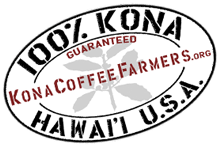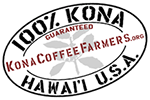“Best Agricultural Newsletter in Hawaii”
Newsletter of the Kona Coffee Farmers Association August 2018
PO Box 5436 Kailua Kona Hawaii 96745 USA
www.konacoffeefarmers.org info@konacoffeefarmers.org
Contents
Candidates Respond to KCFA Questionnaires
What are Your Coffee Problems?
Drying Coffee – The Key to Quality
Research on Coffee Drying Methods
Why Some Coffees are Sweeter than Others
100% Hawaiian Macnuts with 100% Kona Coffee
Coffee,Bees and Climate Change
The Unsung Heroines of the Coffee Industry
Social Media 101
USDA 2018 Transportation Reimbursement Program
Recipe: Kona Coffee Satay
Write to Us
Editor – Clare Wilson
Candidates Respond to KCFA Questionnaires
In the last week of June KCFA’s Legislative Committee sent questionnaires with 3 coffee-related questions to 18 candidates for West Hawaii state legislative offices, for Governor, and Lt. Governor. The three-part questionnaire asked each candidate if they supported: (1) a 51% minimum genuine content for Hawaii coffee blends; (2) required disclosure of the percentage of genuine content in Ready-To-Drink coffee products labeled as Hawaii coffee or Hawaii coffee blends: and (3) enactment of a video conference system for neighbor Island residents (such as Kona coffee farmers) to testify at legislative committee hearings in Honolulu. Fourteen candidates responded—most giving very helpful comments explaining the basis for their positions. We are delighted that, with one exception, all candidates indicated they support each of these three KCFA positions. We very much appreciate the time and thought given by the candidates in their responses.
In making voting decisions for the August 11 primary election and for the November 6 final election, we encourage KCFA members and those who support coffee growers to carefully review the candidates’ responses and comments. In particular, the comments will be helpful in making voting decisions.
To review the full text of the questions, and the candidates’ responses and comments, go here
—Submitted by the Legislative Committee.
Drying Coffee: the Key to Quality

Estate processors, if you invest in one piece of equipment this harvest season, make it a high-quality moisture meter. Proper drying of parchment is likely the single most important post-harvest quality step, even greater than fermentation and roasting.
There are several key aspects for those drying their coffee in-house. First, get it visibly dry as fast as possible. The longer your parchment stays wet, the greater the risk that sugars on the bean will continue to ferment or even mold. Ideally, within 4-12 hours your coffee will be dry to the touch. Mauka farms can struggle with this and may need more space to thin out wet coffee, or a mechanical dryer. Rake frequently and turn your coffee so all layers dry equally. On a hot day, frequent raking will keep your coffee safe from high heats as some makai hoshidanas can reach above 120F. And once your coffee is touch-dry, be sure to prevent your coffee from getting wet again. Parchment that gets rained on will cup with off-flavors as it ages.
When it’s time to remove from the deck, be absolutely sure your coffee is between 9-12% moisture, with 11% being the ideal balance for those who sell green coffee. On a wood deck, this will take 5-10 days, depending on your elevation. Longer dry times are not necessarily a bad thing, as it usually indicates a slower drying process at lower heats, which is safer for the beans. Coffee stored above 12% moisture will age poorly, and possibly even mold. It will introduce bad flavors to your precious crop and reduce your cupping scores. Coffee below 9% can negatively impact flavor, as well as cost you weight and lower your green value. This is why a moisture meter is important.
Now that you’ve gotten it properly dry, store it in reusable Grainpro bags (available on the KCFA website), locking out insects, oxygen and humidity. Ultimately, quality is our key goal, as that brings us repeat customers and allows us to build our markets. Recognize the challenges you face, mauka or makai, and plan for the season ahead.
–Submitted by Suzanne Shriner
Research on Coffee Drying Methods
I would like to introduce myself to you. I am Hassan M Masri a doctoral candidate in food science and technology at Virginia Tech whose dissertation research project focuses on post-harvest practices for Kona coffee produced on the Big Island of Hawai’i.
I traveled to the Kona coffee growing region of Hawai’i in November to December 2017 to complete the first part of my research. I measured the moisture content, water activity, and relative humidity on a daily basis for lots of coffee beans from 10 farms that agreed to participate in my study “anonymously”. Even though producers can consistently dry their coffee to 9-12% final moisture, the drying rate and drying time for batches of coffee beans can vary greatly. Controlled and consistent drying procedures for green coffee may improve coffee quality and discourage mold and mycotoxin formation. Drying coffee beans will reduce both the moisture content and the water activity. Water activity and moisture content are often not correlated.
The second step in my research is to survey all Kona coffee belt growers, processors, and millers. I am asking general questions about your operations and type of drying techniques. All data collected from the survey is saved and not shared with any other entities and your identity will be “anonymous”. Please answer the survey by clicking here: Kona coffee Processing. This survey should take less than 5 minutes to complete.
Tell Us About Your Coffee Problems – Growing/Processing/Marketing…

We’d like to hear from our KCFA members-you! In order to serve you better, we would like to ask what problems are you facing in your coffee business that we might not be aware of. How can we help??? Please email us here: info@KonaCoffeeFarmers.org with your concerns and/or suggestions. Mahalo!
–Submitted by Armando Rodriguez
_________________________________________________________________________

Final suckering and Selection of your coffee should be done by end of August!
______________________________________________________________________________
Why are Some Coffees Sweeter than Others?

“Bitter coffee? That’s a thing of the past. Now, specialty professionals and consumers alike want their morning coffee to have a hint of sweetness – and I’m not talking about one that comes from adding sugar or honey. We’ve finally woken up to just how sweet our favorite drink can be naturally. But why is coffee sweet? And, perhaps, most importantly, how can we roast and brew our beans to maximize it?”
Check out this informative article from the Perfect Daily Grind to get the answers: https://www.perfectdailygrind.com/2017/04/coffees-sweeter-others/
–Submitted by Cecelia Smith
100% Hawaiian Macnuts with 100% Kona Coffee
Hawaii Island’s Hamakua Macadamia Nut Company is offering two products in which its “100% Hawaiian Macadamia Nuts” are flavored with genuine 100% Kona Coffee. The next time you are in Costco, KTA, Target or Longs look for “Kona Coffee Macadamia Nut Brittle”.

The second product is “Kona Coffee Glazed Macadamia Nuts”. Both are flavored with genuine 100% Kona Coffee from Waiaha River Coffee Company of Holualoa.
|
|||||
| –Submitted by Bruce Corker
|
|||||
Coffee, Bees and Climate Change
Coffee and bees can survive climate change. Despite warnings that bees are doomed, an international team of bee experts have found that there is enough resilience among tropical bees in Panama to allow coffee plants to be pollinated in many areas even as global warming events take effect. They used an improved modeling method incorporating more data and taking into account topography. Read more of the Smithsonian Magazine’s article here: https://www.smithsonianmag.com/smithsonian-institution/tropical-bees-and-coffee-will-survive-climate-change-smart-planning-180964836/
–Submitted by Christine Coleman
The unsung heroines of the Coffee Industry
“When women are treated equally in the industries that they power, not only do their lives improve, but the entire world rises with them.”
Looking at the low number of women in roles above picking coffee in the international coffee industry, the International Women’s Coffee Alliance was formed with the intention of uniting the women involved in all aspects of coffee. At this time, 22 countries are participating with the intention of empowering women through coffee.
For more information, follow this link: https://www.linkedin.com/pulse/unsung-heroines-coffee-industry-victoria-lynden
–Submitted by Christine Coleman
Social Media 101
Studies show that 74% of consumers make purchasing decisions influenced by social media. It can seem like a daunting task for a small business to take on, but a social media presence is now a baseline entry point for those who need to build more market share. Luckily, there are tricks to make it easier. First, pick one outlet. Many marketers recommend Instagram, for its visual punch (and also because you can cross-post to Facebook), but choose what works for you.
Second, follow the six key marketing tips: 1) separate your personal and business accounts; 2) set your feed to “public” to ensure the most visibility; 3) follow friends, business customers, and key industry influencers so that they might follow you back and share your content; 4) show real life, and let people connect with your farm; 5) ENGAGE back with those who engage with you (even just liking a comment will boost your Insta feed) and: 6) spread your posts out over time (free calendars such as later.com can assist with this. You can write a bunch of posts at once and then schedule when they will go live.).
Using hashtags on Insta will boost engagement by 12.9% or more. For example #KonaCoffee, #Aloha, #Yourfarmname, will allow people to find you on the “Explore” page if they search for any of these terms. While both FB and Insta allow you to boost your post for a small fee, it isn’t always necessary to do this. Save this option for promotions or around key holidays when you want to reach the broadest audience.
Coming into the busy harvest season, we have a ready supply of visual content. It’s a good time to build buzz for the holidays and deepen your brand loyalty. Don’t be nervous, just #MakeItHappen. #ConnectwithyourCustomers. #SellMore.
–Submitted by Suzanne Shriner
USDA Announces Signup for the 2018 Reimbursement Transportation Program
The Reimbursement Transportation Cost Payment Program (RTCP) RTCP, which offsets a portion of the costs of transporting agricultural products over long distances, is now open for applications. This program helps farmers and ranchers outside the 48 contiguous states who are at a competitive disadvantage when transporting agriculture products to market. It covers partial reimbursement for a number of items: gasoline, fertilizer, freight and other materials that you likely use on your farm.
RTCP payments are calculated based on the costs incurred for transportation of the agricultural commodity or inputs during a fiscal year, subject to an $8,000 per producer cap per fiscal year. In the event that claims for payments exceed the funds available from the program for a fiscal year, payments will be reduced on a pro-rata basis.
For more information on RTCP, Hawaii farmers can visit their administrative FSA county office or the FSA website at www.fsa.usda.gov/pricesupport.
–Submitted by Suzanne Shriner
Recipes Wanted! If any of you have coffee recipes that you would like to share, please submit them to the editor: clare@huahuafarm.com
Recipe: Kona Coffee Satay
Ingredients:
2 lb pork tenderloin
2 garlic cloves, minced
1 tbsp salad oil
2 tsp chili powder
2 tsp coriander
1 tsp ginger
3 tbsp brown sugar
1 tbsp lemon juice
¼ cup coffee
Slice pork ¼ inch thick and 1 inch wide. Combine all other ingredients in a glass dish and marinate pork several hours or overnight.
To prepare, remove pork from marinade and blot dry. Thread on bamboo skewers. Broil or grill pork about 4 minutes on each side.
Can substitute chicken or beef for pork.
LET US KNOW WHAT YOU THINK! >> Write to us. We welcome Letters to the Editor up to 150 words. We reserve the right to edit for clarity and length. Include your name and email address >> Email: info@KonaCoffeeFarmers.org with SUBJECT: Commentary.


